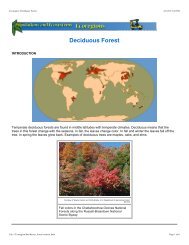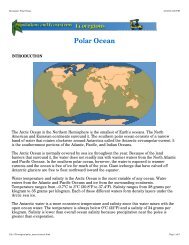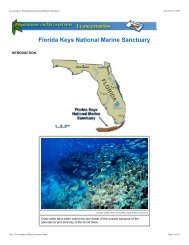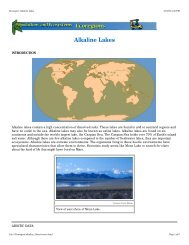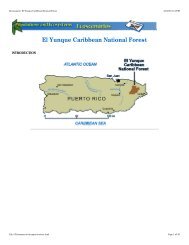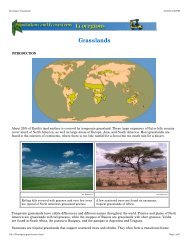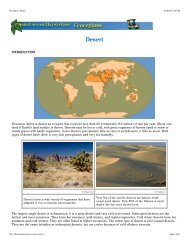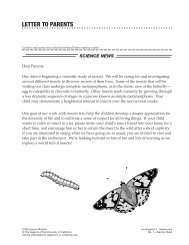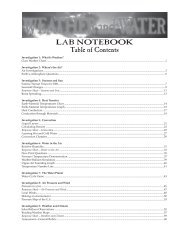Ecoscenarios Combined - FOSSweb
Ecoscenarios Combined - FOSSweb
Ecoscenarios Combined - FOSSweb
Create successful ePaper yourself
Turn your PDF publications into a flip-book with our unique Google optimized e-Paper software.
Ecoscenario: Everglades National Park<br />
4/16/03 3:15 PM<br />
the park also affect the system.<br />
There are some water-control measures in operation now to hold fresh water temporarily and then flood the<br />
Everglades. Unfortunately, water is released during both the wet and dry seasons. Some animals in the Everglades<br />
are adapted for particular patterns of wet and dry seasons. Changes in the amount, quality, and timing of water in<br />
the ecosystem affect the plants and animals that live there. Animals such as apple snails and alligators build their<br />
nests along the high-water line. When more water is allowed to flow into the Everglades, whether in the wet or dry<br />
season, these nests are flooded and the eggs destroyed. Water diverted in the dry season causes the water to be<br />
too low to support apple snail and snail kite populations. When water levels are low, salt water from the ocean can<br />
seep into the water table and damage the animals and plants that can tolerate only fresh water.<br />
Fertilizers and other pollutants are being washed into the water from agricultural areas and cities. Runoff from<br />
agricultural areas flows into the Everglades, destroying algal mats and poisoning fish.<br />
Water diversions have destroyed 65% of the original extent of the Florida Everglades ecosystem.<br />
The Everglades ecosystem is home to many threatened or endangered species. The list includes West Indian<br />
manatee, Florida panther, American alligator, American crocodile, snail kite, Schaus swallowtail butterfly, wood<br />
stork, several sea turtles, and many other animals. One plant, Garber's spurge, is also on the threatened species<br />
list. These organisms have very small populations because they no longer have access to appropriate habitat.<br />
Humans killed some of the animals for sport or because they saw them as a nuisance. Some people think that<br />
endangered species should not be protected, because they cannot survive in a world modified by humans. However,<br />
there are laws to help the populations of these organisms.<br />
For each endangered species a specialized plan considers all the factors it will need to survive. For instance, the<br />
plan for Florida panther conservation and recovery includes corridors of wetlands that would allow the large cat to<br />
travel widely when hunting.<br />
Restoration efforts<br />
A program called Save Our Everglades was started by the State of Florida in 1983. The goal was to make the<br />
Everglades ecosystem look more like the Everglades of 1900 by the year 2000. An area of 23,000 square<br />
kilometers (9000 square miles) was targeted for this program. Plans included trying to make the waters cleaner by<br />
reducing pollutants and restoring habitat.<br />
This project resulted in the expansion of Everglades National Park in 1989 to its current size of 566,700 hectares<br />
(1,400,300 acres) to help stop the decline of some of the seabirds. This boundary change directed the Army Corps<br />
of Engineers to build water structures that would restore the sheetlike flow of water in the Everglades. In 1996<br />
Congress approved $200 million to help restore the Everglades.<br />
Congress accepted a $7.8 billion plan for additional restoration efforts in 2000. Some of this restoration would<br />
include removing or modifying some of the water-diversion structures to increase the amount of water flowing into<br />
the Everglades. It would also involve building reservoirs in the Everglades to hold fresh water. Before making such<br />
changes, agreements had to be negotiated among all those who had interests in preserving the Everglades or using<br />
the water, such as environmentalists, businesses, agricultural interests, and government officials.<br />
The plan's design did not please some environmentalists. They felt it gave too much control to the Army Corps of<br />
Engineers, who would change the water structures. Instead, the environmentalists suggested generating funds for<br />
Everglades restoration by taxing sugar cane. The sugar industry spent $24 million encouraging Floridians to vote<br />
against this alternative plan, ultimately defeating it.<br />
THE DEBATE<br />
Before making decisions that affect an ecosystem, it is important to gather information from a variety of sources.<br />
Below are the views of several individuals or groups that have an interest in the future of Everglades National Park.<br />
After each quote the hyperlink goes to the original source of the quote. Refer to these sites for more information.<br />
Use the information provided to decide where you stand on this debate.<br />
file:///Ecoscenario/everglades/content.html<br />
Page 13 of 17



